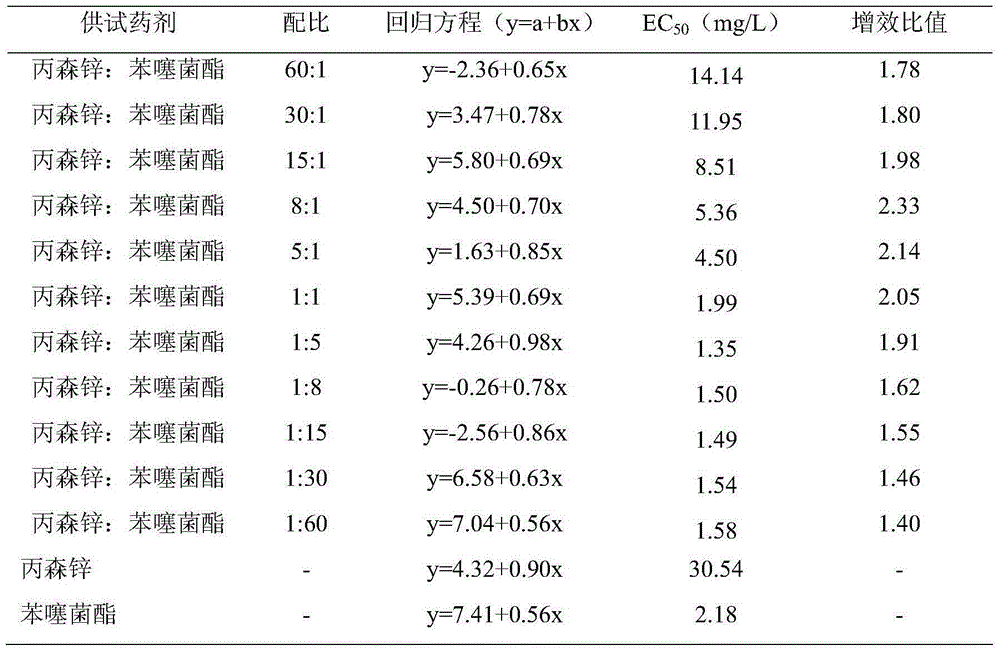Pesticide bactericidal composition
A composition and pesticide technology, applied in the field of pesticides, can solve the problems of no research or report on the compounding of benzathystrobin and thiocarbamate fungicides, pathogenic bacteria developing drug resistance, and increasing the dosage of drugs , to achieve significant synergistic effects, reduce the number of spraying, and save resources
- Summary
- Abstract
- Description
- Claims
- Application Information
AI Technical Summary
Problems solved by technology
Method used
Image
Examples
Embodiment 1
[0058] Example 1 Efficacy test of 30% phenthiastrobin · Propineb wettable powder in the control of capsicum anthracnose
[0059] Prozeb 25%, Penthiastrobin 5%, Sodium Lauryl Sulfate 2%, Lignosulfonate 3%, Polycarboxylate 3%, Filler Kaolin make up 100%. The mixture was mixed according to the above ratio, and pulverized by an airflow mill to obtain 30% phenthiastrobin·propineb wettable powder. The preparation is diluted 500 times and sprayed, and sprayed at the early stage of the disease, and the active ingredient dosage per mu is 10g. The medicine was applied every 7 days, and the medicine was applied 3 times in total. The disease index was investigated 7 days and 14 days after the last medicine, and the control effect was calculated. The control effects of pepper anthracnose on 7 days and 14 days after spraying were 90.35% and 86.20%, respectively.
[0060] 70% propene zinc wettable powder and 10% penthiastrobin emulsifiable concentrate were diluted 1400 times and 1000 times...
Embodiment 2
[0061] Example 2 Drug Efficacy Test of 45% Penthiastrobin · Zinc Wettable Powder in Controlling Apple Spot
[0062] Zinc 30%, penthiostrobin 15%, sodium dodecylbenzene sulfonate 3%, calcium lignosulfonate 5%, kaolin supplement 100%. The mixture was fully mixed according to the above ratio, and pulverized by an airflow mill to obtain 45% fenthiastrobin · zinc zinc wettable powder. The preparation was diluted 750 times and sprayed, sprayed at the early stage of the disease, the active ingredient dosage per mu was 10g, and the medicine was applied once every 7 days, and the medicine was applied 3 times in total. The disease index was investigated and the control effect was calculated 7 days and 14 days after the last medicine. . The control effects of apple spot disease on 7 days and 14 days after application were 90.16% and 92.50%, respectively.
[0063] 80% Zinc WP and 10% Penthiastrobin EC were diluted 1000 times and 500 times respectively, the active ingredient dosage per m...
Embodiment 3
[0064] Example 3 Drug Efficacy Test of 48% Penthiastrobin Mancozeb Water Dispersible Granules in Controlling Apple Spot
[0065] Mancozeb 36%, Penthiastrobin 12%, Sodium Lauryl Sulfonate 3%, Sodium Lignosulfonate 5%, Naphthalene Sulfonate Formaldehyde Condensate 2%, Polyvinyl Alcohol 4%, Calcium Chloride 2 %, filler bentonite makes up 100%. The mixture is fully stirred and mixed according to the above ratio, pulverized by an airflow mill, added with water, extruded, granulated, and dried to obtain 48% pentathiostrobin-mancozeb water-dispersible granules. The preparation is diluted 800 times and sprayed, and sprayed at the early stage of the disease, and the active ingredient dosage per mu is 10g. The medicine was applied every 7 days, and the medicine was applied 3 times in total. The disease index was investigated 7 days and 14 days after the last medicine, and the control effect was calculated. 7 days and 14 days after application, the control effects of apple spot disease...
PUM
 Login to View More
Login to View More Abstract
Description
Claims
Application Information
 Login to View More
Login to View More - R&D
- Intellectual Property
- Life Sciences
- Materials
- Tech Scout
- Unparalleled Data Quality
- Higher Quality Content
- 60% Fewer Hallucinations
Browse by: Latest US Patents, China's latest patents, Technical Efficacy Thesaurus, Application Domain, Technology Topic, Popular Technical Reports.
© 2025 PatSnap. All rights reserved.Legal|Privacy policy|Modern Slavery Act Transparency Statement|Sitemap|About US| Contact US: help@patsnap.com



